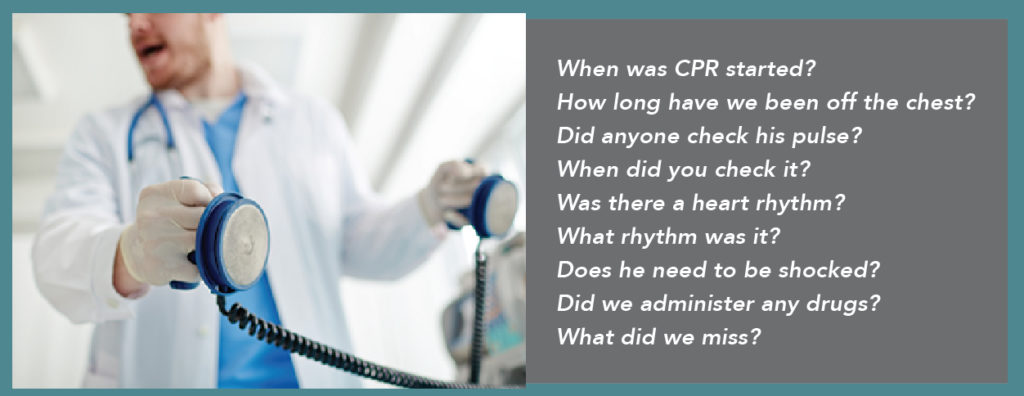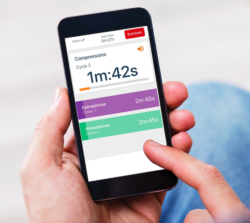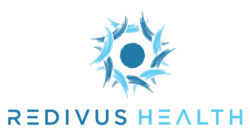June 5, 2019
A GPS for Cardiac Arrest: In Life-or-Death Moments Clinical Apps Save Lives

Resuscitating Your Patients and Building Your Clinical Reputation
The plane is in a nosedive. The sweating pilot is fighting to control the aircraft. A nervous co-pilot is furiously flipping through the flight manual for instructions. What button should they push? What switch should they flip? Was it push or pull on the yoke? How much time do they have?
That familiar scene from every airplane disaster movie should be top-of-mind for hospital leaders when they evaluate how their clinical staff responds to Code Blue alarms for cardiac arrest. These are chaotic events in the best circumstances, even worse for clinical teams that rarely experience them. But, they follow predictable paths that unfortunately lead to bad endings.
Most patients who experience cardiac arrest at hospitals don’t survive. They die. They die in the one place dedicated to keeping patients alive. They die surrounded by medical professionals trained to keep patients alive.
280,000: Number of adult patients suffering in-hospital cardiac arrests per year Source: Circulation
Clinical applications can turn state-of-the-art protocols into action plans at the bedside, in real time. They eliminate the reliance on recall, reduce cognitive overload and give clear directions for clinicians—all of which are especially critical for those who encounter Code Blues infrequently. The algorithm-fueled apps reduce the chances of human error. Failure to adopt these tools in hospitals kills patients.
It’s time for a new script. Imagine hospitals where technology is instantly available to support care teams during critical patient events, including when they’re experiencing cardiac arrest.
This isn’t the movies. These effective clinical tools are available today.
“The best outcomes occur when rapid interventions are initiated on time and done properly. The worst outcomes occur from the exact opposite.” —Michael Ruhlen, M.D., Vice President Medical Education, Atrium Health
THE CODE BLUE BLUES

The numbers tell a depressing story. Nearly 300,000 patients annually suffer in-hospital cardiac arrests (IHCAs). Three out of four don’t survive until discharge. Almost nine in 10 don’t survive until discharge when an IHCA occurs on an unmonitored hospital floor.
The poor results happen even though hospital staff who care for critical patients receive training in Basic Life Support (BLS) and/or Advanced Cardiac Life Support (ACLS). Why? The protocols are complicated. One missed or poorly-performed step can cause an avoidable death. When every second counts, any hesitation worsens outcomes.
Why isn’t training enough? Experts suggest the following reasons why BLS- and ACLS-trained clinicians fail to save patients experiencing cardiac arrest.
- Low volume/lack of practice: According to a 2017 report from the American Hospital Association, hospital admissions in 2017 totaled more than 36.5 million. Individuals experiencing IHCAs constitute less than 1 percent of admitted patients. Consequently, not many clinicians have deep Code Blue experience.
- Location: ED and ICU clinicians see the most Code Blues. However 40 percent of IHCAs happen on general inpatient floors, surgical or dialysis units, not in the ED or ICU. Most staff on those floors and units rarely if ever experience a patient in cardiac arrest. They can’t become expert at it.
- Care team composition: Care teams in all situations perform better when they have worked together, know each other’s strengths and roles, communicate effectively and efficiently. In today’s hospital environment, consistency of the team is less likely with shift changes, staff turnover, assigned agency nurses, float pools, on-call staff and locum tenens doctors. Clinicians who respond to Code Blue events may not know each other and will function like it.
- Staff hierarchy: Everyone is an empowered equal on the clinical team in the ED, ICU, units and floors, but some staff are more equal than others. Practice specialties, academic degrees, training, seniority and other less objective criteria establish hierarchies that govern patient treatment, particularly in moments of crisis. As a result, the individual who runs the code may not be the most qualified or experienced.
- Stress and anxiety: The patient’s heart has stopped or has gone into a dangerous arrhythmia. Even the most experienced, well-trained clinician is impacted by adrenaline, can suffer performance anxiety, misremember or skip critical steps during a Code Blue. Certainly not on purpose.
Research shows that clinical staff members make errors in 30 percent of IHCA cases. What hospitals and cardiac arrest patients need is a digital, clinical-decision support tool at the point of care. An effective decision tool can manage team activities and minimize mistakes. These decision tools give patients a fighting chance to survive an ICHA.
“In the first few moments of a code, there’s a lot of adrenaline flowing. It’s hard to think clearly or systematically. It’s also difficult to remember the heart rhythms and all the steps.” —Kristy Blomquist, R.N., ICU Nurse, University of Kansas Hospital; Clinical Specialist, Redivus Health

HOW CODE BLUE APPS ANSWER PATIENT NEEDS
With a complicated, time-sensitive protocol, a Code Blue is one of the most crucial emergencies to support with a clinical-decision application. Knowing cardiac arrests happen everywhere in the hospital, that Code Blue app must work on a mobile device (tablet or smartphone) at the point of care. It must have a user-friendly interface that staff can read and enter data throughout the episode.

The app must give clear directions that guide clinical teams through cutting-edge treatment protocols with step-by-step instructions, directions and checklists. The app augments decisions the bedside team makes, then documents the steps they follow. It gives intuitive on screen prompts that eliminate distractions and keep teams focused on delivering lifesaving measures, in the right order and for the right amount of time.
Think of it as a GPS for cardiac arrest on your smartphone: Start code. Receive directions. Confirm steps. End Code.
During a Code Blue, clinical-decision support tools can address the five variables that cause clinical staff to deliver suboptimal care.
- Reduces concerns about inexperience because staff doesn’t rely on memory to remind them what to do when, regardless of the course the code takes.
- Mitigates location because it’s portable, and staff can use it on any handheld device in any location in the hospital to provide the same quality of care.
- Improves care team effectiveness because the app puts every member of the care team, no matter how disparate, on the same digital page during the emergency.
- Neutralizes staff hierarchy because the app is agnostic and doesn’t distinguish between degrees, specialties or organizational charts.
- Decreases stress and anxiety because it calmly and objectively tells team members exactly what to do in a chaotic situation.
An app like this will give your staff the clinical-decision support tool needed at the point of care to achieve 100 percent compliance with ACLS. And give IHCA patients their best chance to survive.
“To me, what the app does is walk you through everything you have to do, in order, the right way. You don’t have to worry about timing or when to do what.” —Anthony Fangman, M.D., Clinical Innovation and Hospital Division Chair, Saint Luke’s Health System, Kansas City, Mo.; Co-Founder, Redivus Health
WIDESPREAD BENEFITS
Clinical-decision support apps for IHCA generate numerous short-term and long-term benefits.
Let’s start with patients. When care teams perform Code Blue procedures correctly, patients stand a significantly higher chance of survival. The “survival to discharge” rate at hospitals improves, often dramatically.
Precise adherence to Code Blue protocols helps avoid long-term, negative, physical and mental effects that frequently occur when care teams administer steps incorrectly or with inexact timing.
For example, the patient may experience psychological impairment or permanent brain damage if oxygenated blood doesn’t reach their brain for an extended period. These adverse treatment events often create long-term financial consequences for patients who subsequently cannot work, need rehabilitative services and/or require perpetual post-acute or home-care services.
Clinical staff members receive multiple benefits, including:
- Job satisfaction. The care teams save lives. They can enjoy the personal and professional satisfaction that comes with doing the job that they were trained to do.
- No regrets. When patients die despite by-the-book administration of Code Blue protocols, care teams know that they did everything possible to save a life. They avoid “second-victim syndrome” caused by guilt and anguish from not doing everything possible to save a patient.
- Less paperwork. Some apps provide clinically accurate documentation for patient records and billing purposes in real time.
In most Code Blue events, haphazard handwritten documentation is occurring during the code. The staff is scribbling notes on scraps of paper, napkins, scrubs, bare arms and anything that will accept ink.

After the code, the staff has to reconstruct the event using the notes to document the episode in the patient’s medical record. Not only does that documentation in the patient’s record take time to compile, it also may be inaccurate as doctors and nurses try to record things that happened earlier during a high-stress situation. Without intuitive software, the “who-did what-when” documentation is the clinician’s best guess based on memory to fill in the gaps between all those handwritten notes.
The Redivus Health Code Blue clinical decision support app, for example, records everything that’s done, when it’s done and for how long it’s done. The app is interoperable and integrates with any EHR system. Its documentation of the entire Code Blue event is immediately and accurately sent into the patient’s medical record.
Immediate, accurate and consistent documentation is a key benefit provided by clinical decision support tools. The treatment documentation supports quality assurance and inpatient safety initiatives. It improves care coordination. When relevant, it reassures family members that treatment followed best protocols. Accurate treatment records also enhance organizational risk management by providing comprehensive treatment documentation.
“One beautiful aspect of the app is that it documents and timestamps the interventions ordered in a way that it can be electronically added to the medical record.” —Michael Ruhlen, M.D., Vice President Medical Education, Atrium Health
REDIVUS: ACCURATE ROUTES THROUGH CODE BLUE

Jeff Dunn, D.O., co-founder and CEO of Redivus Health, can tell you the exact incident that pushed him to create the Redivus Code Blue cardiac arrest clinical-decision support app.
“I remember in 2012 I was called in for a Code Blue on a 62-year-old patient whose heart had stopped. We ran down the protocol the best we could, and we lost that patient. The way I felt…the way I turned it over in my head again and again, trying to assure myself we had done everything right. I just couldn’t be sure.”
Dr. Dunn was working as a hospitalist in an 11-hospital system. Outside the emergency department, the people running Code Blues were hospitalists, internists like him. They had to know the latest Advanced Cardiac Life Support guidelines really well, and implement them under stress.
“The patients need the best care possible, no matter who is making the decisions, even if we’ve never worked together as a team.”
Smaller hospitals may not staff critical care specialists or have fully functioning ICUs. The Code Blue team outside the ED might be family doctors, internists, or a dialysis clinician. The intensity and adrenaline stresses staff and leaves an indelible imprint on a provider’s memory even if that life is saved. Imagine the guilt and remorse that go through a provider’s mind when that life is lost.
“I wanted to create a tool that could scale that critical care knowledge to remote places in the hospital and at smaller hospitals. Scale it and put it in the hands of clinicians outside the ED and ICU.”
The Redivus Code Blue cardiac arrest app works on any handheld device. With a simple user interface, it walks the team through the evaluation, actions and decisions for each patient, while timing and documenting each step.
“We’ve had nurses come out of a simulation using the app and tell their administrators they want it on every crash cart.”
Health systems of various sizes use the Code Blue now, and it’s delivering better patient outcomes, avoiding clinician regrets, and analyzing accurate documentation to manage risk. Redivus also offers stroke and sepsis apps. Request a demo here.
“We’re giving every code team the tools to treat cardiac arrest patients with the confidence and reliability of a seasoned ED physician or critical care doctor, even if they haven’t run a code in months.”
Download a published case study of how the Redivus Code Blue solution dramatically increases adherence to ACLS techniques by the clinical staff at an academic medical center.
BARRIERS TO ADOPTION
Despite their widespread benefits and cost-effectiveness, IHCA clinical-decision support tools face significant adoption barriers.
Physician acceptance is a common barrier. Many believe they know how to run codes and don’t require an app or device to assist them. Others think IHCAs are so rare that it’s not worth the investment to acquire an app to manage IHCAs.
Even more than physicians, hospitals resist adoption to clinical apps for clinical and financial reasons.
From the clinical perspective, “you don’t know what you don’t know” aptly applies. Every hospital’s IHCA data looks like every other hospital’s IHCA data. With the same survival-to discharge rates as peer hospitals, hospital leaders assume their hospital’s performance is acceptable. Why change (or spend money) on something that’s working? But it’s not working. When 30 percent of codes have errors, patients are dying unnecessarily.
Hospital executives often mistakenly believe that their EHR systems already contain clinical decision support modules for Code Blue. Some EHRs do have support modules, but they’re not designed for use by clinicians during a medical crisis taking place anywhere in the hospital. There’s no time to move the patient near an EHR terminal, log in, click through computer screens to find the right module, read and scroll through the directions before starting resuscitation.
EHR decision support modules are useless if they cannot respond in real time. Convincing hospital executives of this reality is challenging. Many dismiss such complaints as clinicians whining about technology.
TURNING THE TIDE

“Give the app to someone who runs a lot of codes. Once they use it, they will never go back. Now you will have your internal champion who will push for widespread adoption and use.” —Anthony Fangman, M.D., Clinical Innovation and Hospital Division Chair, Saint Luke’s Health System
Seeing is believing. To convince skeptical clinicians, the answer is simple: challenge them to try it. Hospitals should hold Code Blue simulations with all-star care teams and compare how teams perform with and without an app. Once they see the difference, they’ll want the app to use in all IHCAs.
To convince skeptical administrators, the most persuasive arguments involve reputation and money.
Quality matters. Dramatically improved IHCA survival-to-discharge rates are good for business. Efficiency also matters. Efficient documentation saves time, and time saves money. Accurate documentation enhances billing accuracy, payment receipt and risk management.
Ultimately, it’s not about competition or reputation or money. It’s doing the right thing for patients. It’s deciding whether they live or die. Care teams shouldn’t act like confused pilots in a crisis, hoping they can figure out the flight manual instructions before they crash.
Outcomes Matter. Customers Count. Value Rules.
Reports, Surveys, Articles and Research
- Fast Facts on U.S. Hospitals, 2019. American Hospital Association. https://www.aha.org/statistics/fast-facts-us-hospitals
- Heart Disease and Stroke Statistics—2018 Update: A Report From the American Heart Association. American Heart Association
https://www.ahajournals.org/doi/10.1161/CIR.0000000000000558 - “In-Hospital Cardiac Arrest: A Review.” Journal of the American Medical Association. https://jamanetwork.com/journals/jama/article-abstract/2728930
- “Impact of resuscitation system errors on survival from in-hospital cardiac arrest.” Resuscitation. https://www.ncbi.nlm.nih.gov/pubmed/21963583
- “Incidence of Adult In-Hospital Cardiac Arrest in the United States.” Circulation. https://www.ahajournals.org/doi/10.1161/circ.138.suppl_2.23
- “Location of In-Hospital Cardiac Arrest in the United States—Variability in Event Rate and Outcomes.” Journal of the American Heart Association. https://www.ahajournals.org/doi/10.1161/JAHA.116.003638
- “Resuscitation Errors: A Shocking Problem.” Patient Safety Network. Agency for Healthcare Research and quality.
https://psnet.ahrq.gov/webmm/case/155/resuscitation-errors-a-shocking-problem - Strategies to Improve Cardiac Arrest Survival: A Time to Act. National Academies Press. https://www.ncbi.nlm.nih.gov/books/NBK305685/
CO-AUTHOR

Jeff Dunn DO/MBA, is the founder and CEO of Redivus Health, a company with a mission to save lives and prevent medical errors through next-generation clinical decision support. He served as a physician leader with St Luke’s Health System, practicing as a Hospitalist for nearly 10 years, also serving as Chairman of Medicine and Physician Quality Leader. Jeff is an entrepreneur with a love of healthcare, innovation, and technology. As a champion of patient safety and quality, he created the Redivus solutions for cardiac arrest, stroke, sepsis, and other time-critical emergencies. Jeff earned his DO at the Kansas City University of Medicine and Biosciences and his MBA from Rockhurst University.





